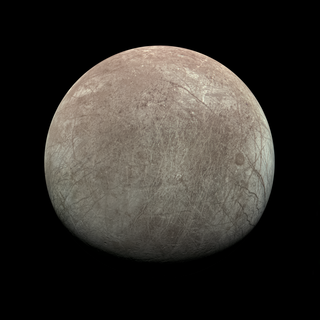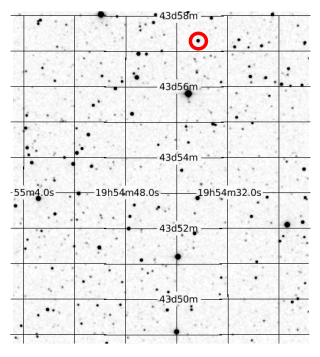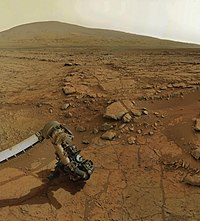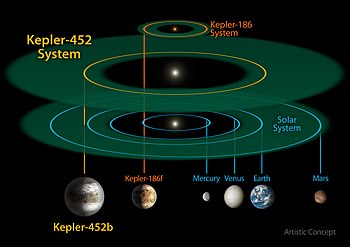
An exoplanet or extrasolar planet is a planet outside the Solar System. The first possible evidence of an exoplanet was noted in 1917 but was not then recognized as such. The first confirmation of the detection occurred in 1992. A different planet, first detected in 1988, was confirmed in 2003. As of 1 May 2024, there are 5,662 confirmed exoplanets in 4,169 planetary systems, with 896 systems having more than one planet. The James Webb Space Telescope (JWST) is expected to discover more exoplanets, and to give more insight into their traits, such as their composition, environmental conditions, and potential for life.

In astronomy and astrobiology, the habitable zone (HZ), or more precisely the circumstellar habitable zone (CHZ), is the range of orbits around a star within which a planetary surface can support liquid water given sufficient atmospheric pressure. The bounds of the HZ are based on Earth's position in the Solar System and the amount of radiant energy it receives from the Sun. Due to the importance of liquid water to Earth's biosphere, the nature of the HZ and the objects within it may be instrumental in determining the scope and distribution of planets capable of supporting Earth-like extraterrestrial life and intelligence.

A K-type main-sequence star, also referred to as a K-type dwarf, or orange dwarf, is a main-sequence (hydrogen-burning) star of spectral type K and luminosity class V. These stars are intermediate in size between red M-type main-sequence stars and yellow/white G-type main-sequence stars. They have masses between 0.6 and 0.9 times the mass of the Sun and surface temperatures between 3,900 and 5,300 K. These stars are of particular interest in the search for extraterrestrial life due to their stability and long lifespan. Many of these stars have not left the main sequence as their low masses mean they stay on the main sequence for up to 70 billion years, a length of time much larger than the time the universe has existed. Well-known examples include Alpha Centauri B and Epsilon Indi.

Planetary habitability is the measure of a planet's or a natural satellite's potential to develop and maintain environments hospitable to life. Life may be generated directly on a planet or satellite endogenously or be transferred to it from another body, through a hypothetical process known as panspermia. Environments do not need to contain life to be considered habitable nor are accepted habitable zones (HZ) the only areas in which life might arise.

The habitability of natural satellites is the potential of moons to provide habitats for life, though it is not an indicator that they harbor it. Natural satellites are expected to outnumber planets by a large margin and the study of their habitability is therefore important to astrobiology and the search for extraterrestrial life. There are, nevertheless, significant environmental variables specific to moons.

An exoplanet is a planet located outside the Solar System. The first evidence of an exoplanet was noted as early as 1917, but was not recognized as such until 2016; no planet discovery has yet come from that evidence. What turned out to be the first detection of an exoplanet was published among a list of possible candidates in 1988, though not confirmed until 2003. The first confirmed detection came in 1992, with the discovery of terrestrial-mass planets orbiting the pulsar PSR B1257+12. The first confirmation of an exoplanet orbiting a main-sequence star was made in 1995, when a giant planet was found in a four-day orbit around the nearby star 51 Pegasi. Some exoplanets have been imaged directly by telescopes, but the vast majority have been detected through indirect methods, such as the transit method and the radial-velocity method. As of 1 May 2024, there are 5,662 confirmed exoplanets in 4,169 planetary systems, with 896 systems having more than one planet. This is a list of the most notable discoveries.

K-type main-sequence stars, also known as orange dwarfs, may be candidates for supporting extraterrestrial life. These stars are known as "Goldilocks stars" as they emit enough radiation in the non-UV ray spectrum to provide a temperature that allows liquid water to exist on the surface of a planet; they also remain stable in the main sequence longer than the Sun by burning their hydrogen slower, allowing more time for life to form on a planet around a K-type main-sequence star. The planet's habitable zone, ranging from 0.1–0.4 to 0.3–1.3 astronomical units (AU), depending on the size of the star, is often far enough from the star so as not to be tidally locked to the star, and to have a sufficiently low solar flare activity not to be lethal to life. In comparison, red dwarf stars have too much solar activity and quickly tidally lock the planets in their habitable zones, making them less suitable for life. The odds of complex life arising may be better on planets around K-type main-sequence stars than around Sun-like stars, given the suitable temperature and extra time available for it to evolve. Some planets around K-type main-sequence stars are potential candidates for extraterrestrial life.

Kepler-62f is a super-Earth exoplanet orbiting within the habitable zone of the star Kepler-62, the outermost of five such planets discovered around the star by NASA's Kepler spacecraft. It is located about 980 light-years from Earth in the constellation of Lyra.

The theorized habitability of red dwarf systems is determined by a large number of factors. Modern evidence indicates that planets in red dwarf systems are unlikely to be habitable, due to their low stellar flux, high probability of tidal locking and thus likely lack of magnetospheres and atmospheres, small circumstellar habitable zones and the high stellar variation experienced by planets of red dwarf stars. However, the sheer numbers and longevity of red dwarfs could provide ample opportunity to realize any small possibility of habitability.

Kepler-186 is a main-sequence M1-type dwarf star, located 177.5 parsecs away in the constellation of Cygnus. The star is slightly cooler than the sun, with roughly half its metallicity. It is known to have five planets, including the first Earth-sized world discovered in the habitable zone: Kepler-186f. The star hosts four other planets discovered so far, though they all orbit interior to the habitable zone.

Kepler-438b is a confirmed near-Earth-sized exoplanet. It is likely rocky. It orbits on the inner edge of the habitable zone of a red dwarf, Kepler-438, about 472.9 light-years from Earth in the constellation Lyra. It receives 1.4 times our solar flux. The planet was discovered by NASA's Kepler spacecraft using the transit method, in which the dimming effect that a planet causes as it crosses in front of its star is measured. NASA announced the confirmation of the exoplanet on 6 January 2015.

Kepler-442b is a confirmed near-Earth-sized exoplanet, likely rocky, orbiting within the habitable zone of the K-type main-sequence star Kepler-442, about 1,206 light-years (370 pc) from Earth in the constellation of Lyra.

Kepler-452b is a super-Earth exoplanet orbiting within the inner edge of the habitable zone of the sun-like star Kepler-452 and is the only planet in the system discovered by Kepler. It is located about 1,400 light-years (430 pc) from Earth in the constellation of Cygnus.

Kepler-452 is a G-type main-sequence star located about 1,810 light-years away from Earth in the Cygnus constellation. Although similar in temperature to the Sun, it is 20% brighter, 3.7% more massive and 11% larger. Alongside this, the star is approximately six billion years old and possesses a high metallicity.

A superhabitable world is a hypothetical type of planet or moon that is better suited than Earth for the emergence and evolution of life. The concept was introduced in a 2014 paper by René Heller and John Armstrong, in which they criticized the language used in the search for habitable exoplanets and proposed clarifications. The authors argued that knowing whether a world is located within the star's habitable zone is insufficient to determine its habitability, that the principle of mediocrity cannot adequately explain why Earth should represent the archetypal habitable world, and that the prevailing model of characterization was geocentric or anthropocentric in nature. Instead, they proposed a biocentric approach that prioritized astrophysical characteristics affecting the abundance and variety of life on a world's surface.

Kepler-1229b is a confirmed super-Earth exoplanet, likely rocky, orbiting within the habitable zone of the red dwarf Kepler-1229, located about 870 light years from Earth in the constellation of Cygnus. It was discovered in 2016 by the Kepler space telescope. The exoplanet was found by using the transit method, in which the dimming effect that a planet causes as it crosses in front of its star is measured.
TOI-700 is a red dwarf 101.4 light-years away from Earth located in the Dorado constellation that hosts TOI-700 d, the first Earth-sized exoplanet in the habitable zone discovered by the Transiting Exoplanet Survey Satellite (TESS).

Kepler-1649c is an Earth-sized exoplanet, likely rocky, orbiting within the habitable zone of the red dwarf star Kepler-1649, the outermost planet of the planetary system discovered by Kepler’s space telescope. It is located about 301 light-years (92 pc) away from Earth, in the constellation of Cygnus.

The habitability of F-type main-sequence starsystems is disputed due to the shorter lifetimes and higher levels of UV radiation. Indeed, F0 stars are considered by many scientists as the hottest and most massive stars capable of supporting habitable planets. A planet orbiting an F-type star at the Earth boundary within the HZ would receive 2.5 to 7.1 times the UV that Earth gets from the sun.



















